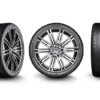Why do some vehicles have wider or thicker tyres than others? Are they actually better? Let’s find out.
Depending on the type of vehicle you drive and the conditions you’re driving it in, the thickness of your tyres can make a considerable difference in the way your vehicle handles.
Below are some differences between wide and narrow tyres, and why having the correct size on your car matters.
Does the width of a tyre matter?

Yes, if it isn’t obvious enough, tyre width does matter! Not only does it alter the overall aesthetic appeal of your vehicle, but switching to wider tyre sets will change the way the vehicle behaves on the road.
Bigger isn’t always better in this case, and there are limits each vehicle can take before you start to see diminishing returns. Now, the big question is what do narrow tyres versus wider tyres offer?
Narrow tyres

When cars were first invented and brought into the mainstream during the early 1900s, they were all equipped with extremely narrow tyres. I mean, just looking at this image of a Ford Model T will give you a good idea of just how narrow these tyres started out.
As time went on, vehicles became heavier and changed drastically, and the size and width of tyres adapted along with the times. Narrow tyres may seem worse, but they still have advantages for some applications.

Narrow tyres are typically better when it comes to winter and snow conditions because their small footprint prevents them from acting like a snow plough in the same way that wider tyres do. Plus, narrow tyres provide higher surface pressure against the road, giving you more traction in snow. Narrow tyres are also more effective when it comes to providing traction on slippery surfaces.
But, are there disadvantages to narrow tyres? While they are still easy to manoeuvre, narrow tyres do not provide the agility and sharpness of wider tyres at high speeds as their contact surface allows heat build-up, causing drops in performance. Furthermore, at high speeds having a larger surface area in contact with the road – achieved with wider tyres – provides additional stability, something which narrow tyres lack more.
Pros
- Improved fuel consumption levels
- Decreased road noise and vibrations
- Secure traction in snow
Cons
- Limited high-speed safety
- Handling is not as sharp
Wide tyres

All of that isn’t to say that narrow tyres are always your go-to option. There’s a reason why the majority of cars have slightly wider rather than narrow tyres. Overall, wider tyres are better for dry surfaces and are beneficial in high-performance vehicles that demand more contact area in order to put the power down. Conversely, wider tyres have an increased risk of hydroplaning on slippery or wet surfaces.
In this manner, wider tyres to a certain extent also significantly upgrade the controllability and high-speed durability of a vehicle, due to the larger footprint creating more traction during manoeuvring.

However, sharp handling and better traction obviously come at a price, which is paid in greater fuel costs. Wider tyres have increased rolling resistance, which negatively affects a vehicle’s fuel consumption. Additionally, the wider footprint also generates higher noise levels, potentially diminishing comfort levels throughout the drive.
Pros
- Better dry and wet weather traction
- Increased handling and manoeuvring
- Optimized high-speed durability
Cons
- Worse fuel economy
- Greater tyre noise levels
- Tyee sets generally cost more
Follow your specifications

Ultimately, your vehicle will come from the factory equipped with tyres that are designed with the specifications of your vehicle taken into account. That doesn’t mean you can’t switch out or modify your tyres, but it does mean you should be mindful when picking up a new set.
The wrong tyre width might make a vehicle more dangerous, so prior research or advice from professionals is always handy to have. Can’t hurt to have a second opinion right?
Tyre rotations are important too! Check out this guide for more information.



















Leave a Comment
Your email address will not be published. Required fields are marked with *